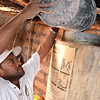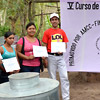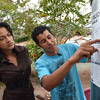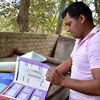The POSTCOSECHA program was developed by SDC in the 1980ies in Honduras and scaled up to Central Amercia. The program ended in 2003, but its post-harvest strategy keeps flourishing today. The main technology element of the POSTCOSECHA program are locally produced metal silos to protect and store grain. The program has sustainably anchored technology production and technology dissemination in existing institutions and market mechanisms.
The massive dissemination of silo technology has been a success. Today, one fifth of all maize and bean producers in Central America own a hermetically sealed metal silo previously unknown in the region. Fumigation allows the silo owners to get rid of damaging insects contained in the grain to be stored. For small-scale farmers the silos represent a secure, long-term and practical solution to a problem that negatively affected the security of their livelihoods.
The strategy of the POSTCOSECHA program consists of 4 elements:
 Technology
Technology
Local tinsmiths produce metal silos. Farmers store their grain in the silos, where it is protected. Fumigation against insect infestation effectively reduces losses.
 Dissemination
Dissemination
Public and NGO training & development institutions propagate the technology and carry out trainings for farmers and tinsmiths.
 Business model
Business model
Public funds are used to finance the strategy support measures. Private funds (family savings or funds from donor institutions) are used by tinsmiths to start or upgrade their businesses, and by farmers to purchase the silos.
 Management mechanism
Management mechanism
Independent project management units (PMUs) manage POSTCOSECHA projects. The main activities of those PMUs are planning, coordination, quality control, and controlling.
back to post-harvest management
